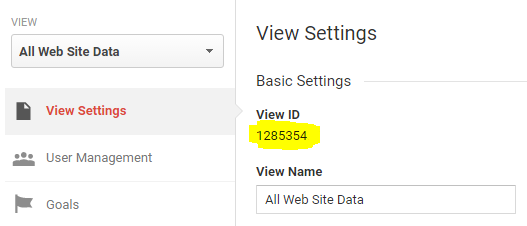Google Analytics¶
Google Analytics is a great way to track what happens on you front website.
The datastore specification have 3 parameters.
Parameters |
Details |
|---|---|
name |
how you want this data store be refered as |
type |
should be googleAnalytics |
viewId |
the identification number of the Google Analytisc view (see below) |
The viewId can be found on the View Settings on the Admin panel of Google Analytics.

You need also to allow Datafactory to access the data. For that, add the account bicloud@bicloud-1.iam.gserviceaccount.com to the User Management settings (just below the View Settings) with Read & Analyse permissions like below:

The you can define any number of table. As you can see in the example below, each table can be provided a startDate and endDate field. You can give it in absolute with a YYYY-MM-DD pattern or using some special keys like today, yesterday, XdaysAgo (where X is a number).
Then, you can define two types of rows, dimensions and measures (you can use the Dimensions & Metrics Explorer from Google ). Columns gaName field correspond to the Google Analytics API name and gaType is either dimension or measure. In case of a measure, type is always bigint. For a dimension it’s varchar.
<dataWarehouse>
<!-- Define where the data warehouse is located. -->
<datastore name="dw" type="postgresql" host="dw.theowner.com" database="datawarehouse"
user="john" password="Doe" sshUser="john">
</datastore>
<!-- Define access to Google Analytics. -->
<datastore name="ga" type="googleAnalytics" viewId="123456789">
<!-- It will import all data from 30 days ago to yesterday -->
<table name="sessions" startDate="30daysAgo" endDate="yesterday">
<!-- We start by defining the dimensions (type = varchar) -->
<column name="date" type="varchar" gaName="ga:date" gaType="dimension"/>
<column name="medium" type="varchar" gaName="ga:medium" gaType="dimension"/>
<column name="source" type="varchar" gaName="ga:source" gaType="dimension"/>
<column name="campaign" type="varchar" gaName="ga:campaign" gaType="dimension"/>
<column name="country" type="varchar" gaName="ga:country" gaType="dimension"/>
<column name="city" type="varchar" gaName="ga:city" gaType="dimension"/>
<!-- Then measures (type = bigint) -->
<column name="sessions" type="bigint" gaName="ga:sessions" gaType="measure"/>
<column name="bounces" type="bigint" gaName="ga:bounces" gaType="measure"/>
<column name="pageviews" type="bigint" gaName="ga:pageviews" gaType="measure"/>
</table>
</datastore>
<!-- Integration layer module : prestashop -->
<!-- In the database it will be store under the m901_prestashop schema -->
<module id="902" name="google_analytics" datastore="dw">
<!-- We replicate all the ga datastore -->
<replicate datastore="ga"/>
</module>
</dataWarehouse>
After having update your data warehouse specification, you can update it on the DataFactory plateform with the command /datawarehouse command (with dw.xml being your data warehouse specification):
curl -X POST -u token:<your_token> -H "Content-Type: text/xml" --data-binary "@dw.xml" https://etl.dataintoresults.com/api/v0/datawarehouse
You can now ask DataFactory to run your refining module with the /run/module command (in this case the module id is 902):
curl -u token:<your_token> https://etl.dataintoresults.com/api/v0/run/module/902